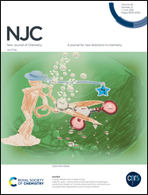Robust fluorescent amphiphilic polymer micelle for drug carrier application†
Abstract
Stimuli-responsive polymeric micelle (SRPM) is one of the research hotspots of drug carrier materials. The drug release process is controlled by the stimulus response of SRPM within the tumor microenvironment, which can not only reduce the damage of small-molecule anticancer drugs to healthy biological tissues or organs but also specifically enrich drug concentration at the tumor site by targeting effects. However, general SRPMs used as drug carriers for cancer treatment lack diagnostic characteristics; however, fluorescence imaging technique with organic photoelectric materials (OPMs) is a potential tool in the bioimaging field. Herein, we synthesized a fluorescent amphiphilic block-polymer with OPM (benzo[c][1,2,5] thiadiazole-4,7-diylbis(4,1-phenylene)) dimethanol as the core, the polymer segments (poly-caprolactone and polyethylene glycol) were modified to form polymeric micelles with robust fluorescence characteristic, and the as-prepared nanodrug carrier simultaneously possessed pH response. The as-synthesized fluorescent SRPMs exhibited high stability and fluorescence property. Moreover, DOX-loaded micelles can deliver therapeutic drugs to cancer cells, and the therapy process is monitored via fluorescence imaging. The design of this fluorescent SRPM provides a promising way to develop new general pharmaceutical preparations with diagnosis and therapy.



 Please wait while we load your content...
Please wait while we load your content...